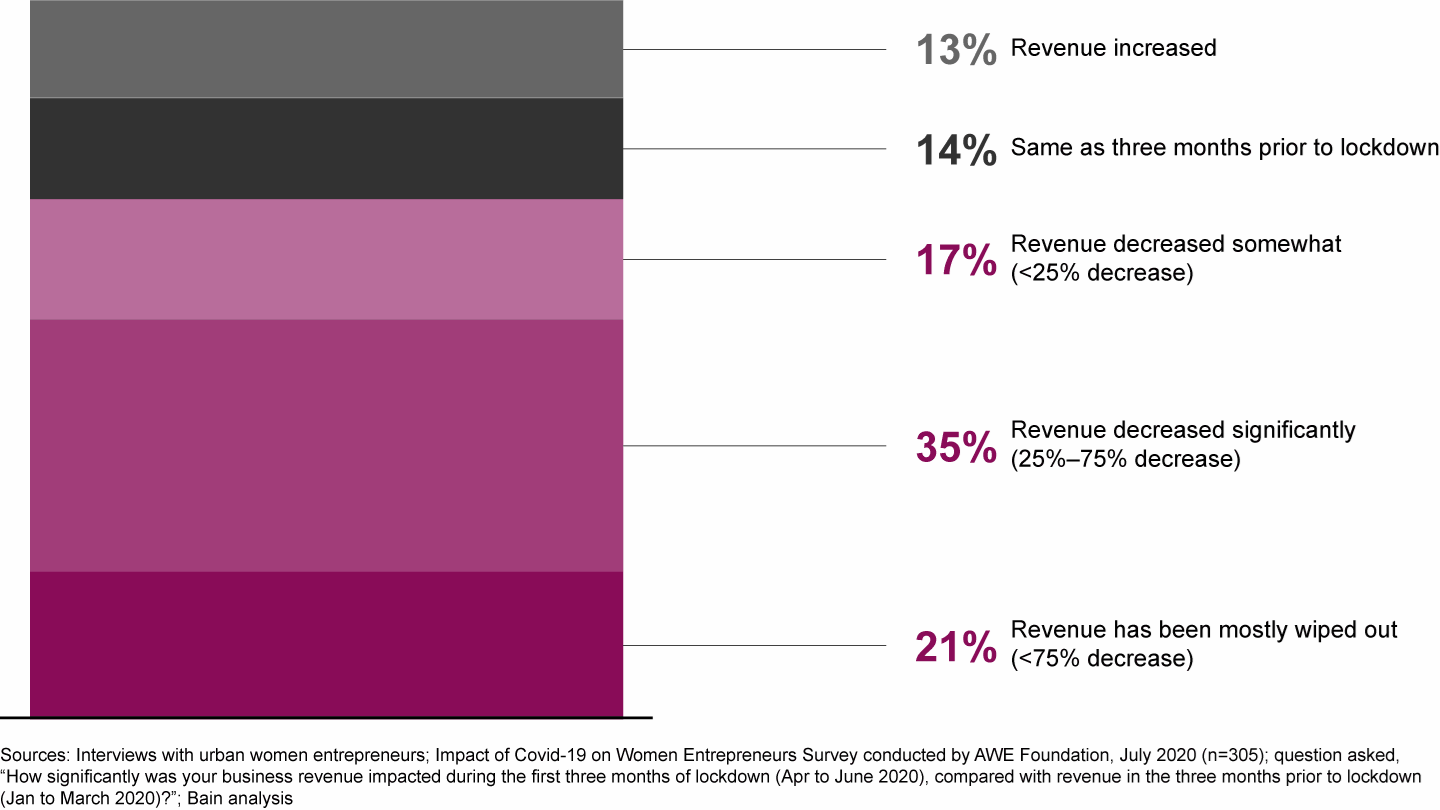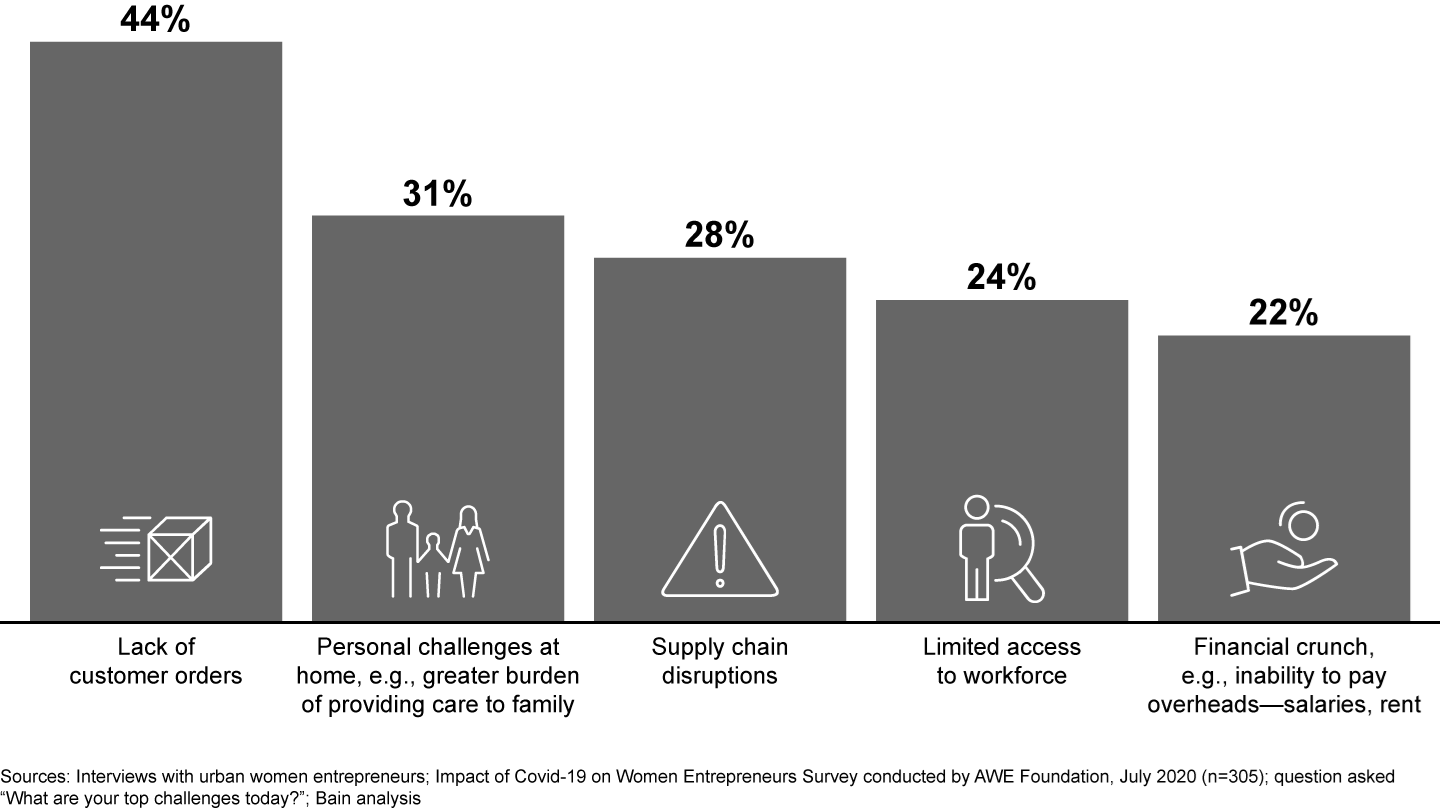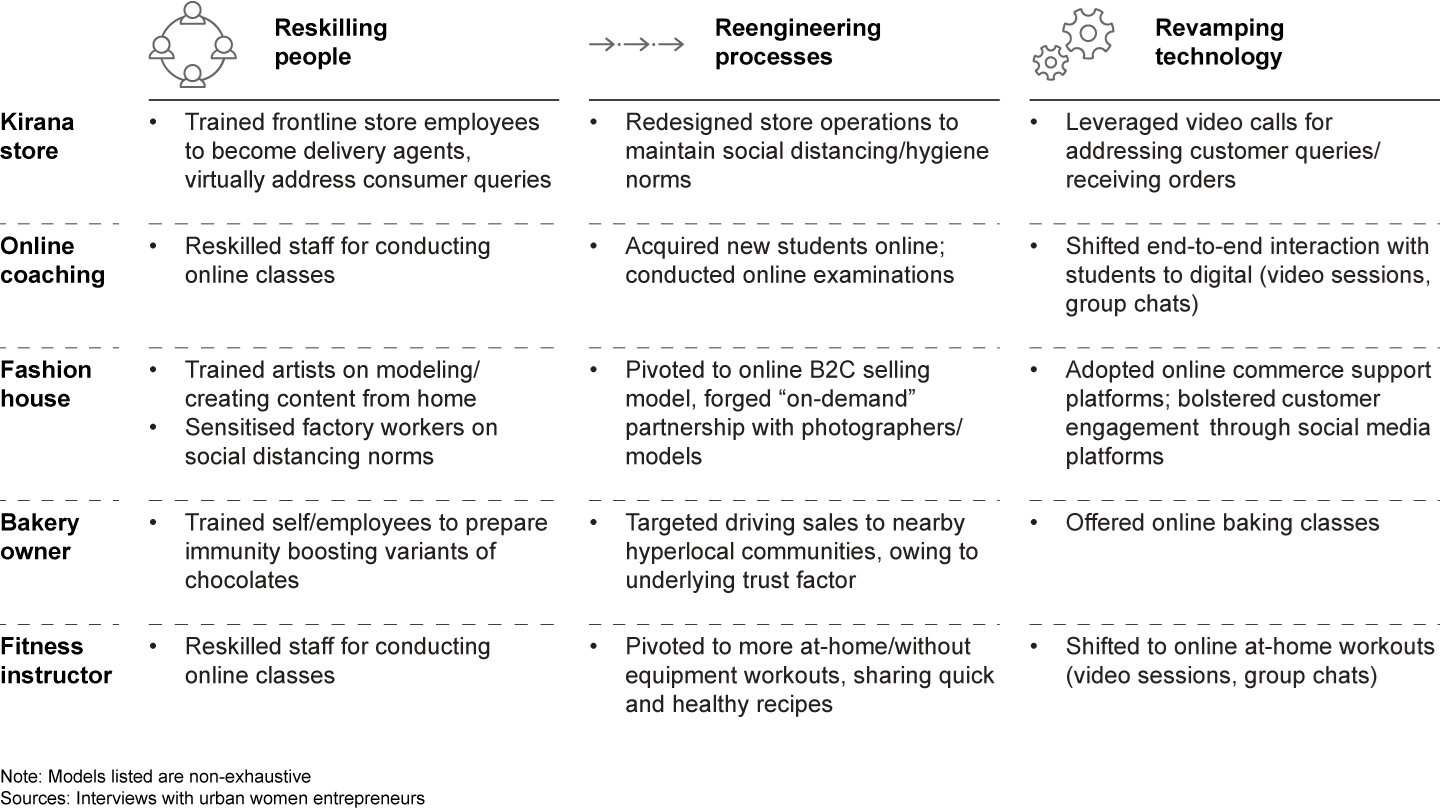Brief

The 432 million women of working age in India are the country’s largest under-tapped economic resource. While women play an important role in Indian society, they remain a neglected segment of India’s paid labour force. In addition to low (and falling) female labour force participation rates, women experience three times more unemployment than men, thus limiting the country’s advancement by not recognising and capitalising on this large pool of talent and enterprise. The proportion of unpaid women workers in India (66%) is much higher than that of men (12%).
In our earlier report Powering the Economy with Her: Women Entrepreneurship in India, we determined how women’s entrepreneurship can be a catalyst for change in their economic role in India. Today, India has 13.5 to 15.7 million women-owned enterprises—fewer than 20% of all enterprises. Largely single-person businesses, they provide direct employment to an estimated 22 to 27 million people. Accelerating growth in the number as well as size of women-owned enterprises can generate potentially transformational employment in India, of 150 to 170 million jobs by 2030. This will require a coordinated multistakeholder approach, across a number of dimensions, including government policy, funding and investments, and formal and informal mentorship.
Covid-19 and the ensuing disruption has disproportionately impacted women. In the near term, women are experiencing increased unemployment and at-home responsibilities, as well as an exacerbation of social injustices. At the same time, Covid-19 has presented some catalysing changes, such as an acceptance of remote working models; acceleration in the use of digital channels on both the demand and the supply side; and a shift towards digital versus physical interactions, all of which have the potential to level the playing field, especially for women. The challenge is to get through the fracturing near-term impact, and, at the same time, design medium-term interventions that will enable women to take advantage of these transformative changes.
For this brief, we surveyed and conducted in-depth interviews with close to 350 women solopreneurs and small business owners in urban India to understand the impact, challenges and opportunities that Covid-19 has triggered for women entrepreneurs.
Covid-19 and its immediate effects on women entrepreneurs
Our research uncovered the primary impact of the ongoing crisis on women entrepreneurs:
- Women-owned businesses experienced a massive decline in revenue. Seventy-three percent of the women entrepreneurs have been negatively impacted by the crisis, with almost 20% witnessing the revenue of their businesses nearly wiped out. Thirty-five percent of the women experienced a significant decline (25%–75%) in revenue of their businesses. Even in cases where businesses did not see an immediate decline in revenue, growth has remained fairly muted (see Figure 1).
- Businesses that were primarily reliant on offline production or delivery models have experienced a far greater decline than those which lend themselves to digital channels.
- Increases in revenue were driven by two factors: increased relevance of specific products and services during the crisis, and a rapid realignment of the business model to address immediate needs.
Over 70% of women entrepreneurs surveyed faced a decline in business revenue due to Covid-driven lockdown and restrictions


- Most of the entrepreneurs’ businesses have not returned to pre–Covid-19 levels. After an abrupt drop in March and April due to the lockdown, growth in businesses is at about one-third of pre–Covid-19 levels. Only select entrepreneurs have been able to return to pre–Covid-19 levels. Enterprises that experienced the fastest recovery were those that had already experimented with or adopted digitalisation in various parts of their business model.
- Despite near-term shrinkage, entrepreneurs are optimistic about the bounce back. Ninety percent of entrepreneurs believe they will be able to survive the crisis, of whom two-thirds believe this requires major changes to their business model and cost structure. Eighty percent of entrepreneurs expect demand to bounce back to pre-lockdown levels by March 2021, and of these, half believe this will happen by December 2020.
- Women have been quick to shift their business models for greater relevance. Fifty-four percent of the women we interviewed have already changed their business model in response to Covid-19, and another 24% plan to make a change by December. Only 6% suggest that they will not be able to shift their business model.
- Business model shifts have included new products or services (60% of respondents), digital sales and delivery channels (35%), as well as a reoriented supply chain and sales and marketing function (26%). Entrepreneurs also focused on retraining themselves and their staff by learning new skills (46%) to adapt to this change.
- The largest impediments to adopting a new business model have been insufficient knowledge to predict demand patterns and a lack of financial resources.
- Working remotely appears to be effective, but is offset by an increase in domestic responsibilities. Operating from home, while enabling greater flexibility in ordinary circumstances, has had a mixed impact on women entrepreneurs during the crisis. Fifty-seven percent of our interviewees report having the same or higher productivity while working from home. However, the 43% that experienced a drop in productivity attribute it largely to increased domestic responsibilities and distractions.
Fifty-four percent of the women we interviewed have already changed their business model in response to Covid-19, and another 24% plan to make a change by December.
Root causes
The impact on women entrepreneurs can be attributed to a few underlying causes (see Figure 2):
Muted customer demand and added domestic responsibilities have been the top challenges faced by women entrepreneurs


- Muted demand: Almost 45% of the women cited lack of customer orders as the biggest challenge. With the lockdowns creating new demand patterns and rendering others obsolete, some business models were at a greater risk. Contact services including salons, dining and gyms experienced a wholesale drop in revenue. Garment, craft and other manufacturing businesses experienced a hit to demand patterns with reduced order frequency and size, as customers reassessed and reprioritised expenses.
- Increased domestic responsibilities: About 30% of women cited personal challenges, including significantly greater at-home care responsibilities, as a major obstacle in running their business. Factors such as home confinement of the entire family, closure of schools, and disruptions in crucial assistance, including house help and childcare, have led to a disproportionate share of domestic responsibilities falling on women. About 40% of respondents cited domestic responsibilities as a reason for the decrease in their productivity during this time. That number is higher for women based in metros/tier-1 cities vs. tier-2/tier-3 cities, potentially due to a higher prevalence of nuclear families.
- Operational disruptions: Twenty-eight percent of respondents cited disruptions to their supply chain as a major challenge. With movement restricted across the country, logistics channels for businesses have been drastically impacted. Even for businesses in the essentials segment (e.g., agri-processing, grocery, and personal protective equipment (PPE) manufacturing), the disruption in channels limited these sectors’ full potential because, despite an increase in demand, they were not able to respond within the regulatory environment. Operational challenges also impeded workforce availability and productivity. While businesses with models compatible with remote working transitioned quickly, other businesses such as those with contract workers in manufacturing and logistics did not. These companies faced issues such as reduced access to labour (owing to migration) and a need for additional investment in employee safety and health.
- Financing crunch: Twenty-two percent of women said lack of financial resources has been a major challenge. Nearly 80% of those interviewed have not applied for financing support, potentially due to growth constraints during the pandemic. Businesses experienced an immediate cash flow crunch due to lower sales and delayed payments. These issues were exacerbated by the need to invest in workforce safety (sanitisation services, protective gear) and remote communication. However, our interviews suggest that while entrepreneurs have downsized to manage cash flow for the short term, financing is expected to become a bigger challenge as demand starts to increase.
Learning from the crisis: Adapting for uncertainty
Women entrepreneurs have aggressively adapted their businesses to resist the short-term impact of Covid-19.
A few characteristics of women-owned enterprises in India, such as being service-oriented, smaller and less capital-intensive, enabled faster adaptation to the changing environment than was possible for larger or more capital-intensive businesses. Examples of such pivots include apparel manufacturers who transitioned to manufacturing safety equipment (masks, gloves, PPE kits), coaching centres and gyms that expanded their reach dramatically by holding “virtual classes,” and food and beverage businesses who leveraged “vocal for local” positioning to reach a wider audience digitally.
As noted earlier, more than half of the respondents said they had shifted their business model within three months of the crisis; and an additional 25% expressed the intent to do so by year-end. Women entrepreneurs who successfully adapted did so in three ways: they acquired new skills, redesigned their processes and accelerated the adoption of technology to tide the crisis (see Figure 3).
Women have pivoted their business models along three dimensions—skillsets, operations and technology


Opportunities for growth
Despite the economic and social setbacks impacting women in India, women have responded rapidly, and are upbeat about surviving through this crisis. In addition, Covid-19 has spurred changes at home and at work that serve as a timely catalyst to accelerate and expand the role of women entrepreneurs in India. The entrepreneurs we interviewed pointed towards two catalysing shifts, which create significantly enabling conditions not only for women entrepreneurs, but for working women at large:
- Increased acknowledgement and support for women’s contribution towards family income. A universal negative impact on jobs and incomes has led to greater familial and societal acceptance of women working formally, which can bolster women’s role in delivering financial support to their families. Thirty percent of respondents believe there will be an increased need to work because of uncertainty in the economic environment, while 20% believe there is a greater acceptance to work among family and community.
- Widespread adoption of remote interactions across the ecosystem. Despite these being extraordinary circumstances, as many as 30% of the respondents believe that working from home improved productivity, with an ability to prioritise better. At the same time, Covid-19 has pushed the broader ecosystem to rapidly adopt digital means to conduct business. As suppliers, customers and employees have adopted remote models, transactions have moved online; and as B2B commerce has scaled up, entrepreneurship has become more accessible to women. Looking beyond the challenging near-term circumstances, these shifts towards virtual or remote interactions have the potential to provide a more enabling environment for women, who often face competing responsibilities that constrain mobility. Forty-five percent of our respondents believe greater adoption of remote work will make it easier for them to run their business successfully in a post–Covid-19 world.
The agility demonstrated by women, altered business and social dynamics, and a dire need for an “all-hands” approach to economic reconstruction, call for a deliberate effort to bring women into the fold of entrepreneurship through targeted interventions.
Key imperatives
The experiences of entrepreneurs provide valuable insight into the mechanisms and resources that have helped them adapt in the near term and maintain a strong optimistic outlook. In addition to broader ecosystem-wide coordination, a few key imperatives emerge as crucial to capitalising on some structural shifts that the pandemic has presented:
- Aggressively bring women into the fold of opportunity creation. Governments will have a crucial role in recognising and elevating women entrepreneurship as a key lever to jump-start economic activity in the current environment. Priority initiatives include:
- A state-led “call to action” for women to directly participate in the economic rebuilding effort, supported by tailored government-led digital interventions to attract and empower women-run enterprises. For example, multiple initiatives under Digital India, such as the engagement of small and mid-size enterprises (SMEs) and the Aatmanirbhar Bharat Innovate Challenge, should be tailored to drive greater participation of, as well as higher enablement for, women.
- Specific sector-focused incentives, policies and programmes (e.g., incubators) that disproportionately focus on encouraging women’s participation in high-growth sectors such as PPE manufacturing, remote learning, and childcare and healthcare training.
- Simplified processes with a responsive hotline to ensure disbursements of available incentives.
- Embrace technology to expand reach and coverage of incubators and accelerators. By mainstreaming virtual engagement models, Covid-19 has provided the opportunity for enabling organisations to pivot their own programmes online for steady-state, and expand their reach to a large number of women entrepreneurs.
- Develop and expand targeted mentorship models. Mentorship is a key enabler for women entrepreneurs, especially in the current environment. Through informal and formal programmes, mentorship must focus on enabling women to swiftly and successfully pivot their business models. Globally, governments in collaboration with the private sector have launched initiatives to support entrepreneurs and create scale-up potential for start-ups. Existing mentorship forums must expand their reach leveraging digital channels, and emphasise topic-based support, in addition to traditional broad-based mentorship. Potential initiatives include:
- Virtual and real-time mentorship platforms to connect entrepreneurs with professionals or other entrepreneurs in the same or adjacent industries
- Mentorship between established and emerging enterprises
- Individual action through pay-it-forward initiatives by entrepreneurs of various sizes and across sectors
- Revamp knowledge and capability building resources to help accelerate recovery and adapt for the post–Covid-19 environment. Organisations such as incubators and accelerators must adapt their formats to include topics which have gained relevance during the pandemic. Specific initiatives include:
- Sector-specific toolkits (live, recorded, on-demand courses) on topics such as consumption shifts and new value propositions, digital and e-commerce acceleration, and scaling digital back-ends
- Context-specific business support tools and resources, such as running remote businesses effectively, sustainable cost management, new operating models, and effective working capital management
- Programmes, potentially in partnership with state governments, focused on enabling women entrepreneurs to start and scale in growth sectors, such as EdTech, B2B commerce, health and nutrition
- Women-focused Covid-19 recovery programmes that include capacity building, data tracking and infrastructure enablement, through partnerships between private and non-government institutions
- Accelerate financial inclusion. Covid-19 has increased the crunch on working capital, exacerbating the wide gender disparity in access to finance. As women entrepreneurs start to plan for recovery, funding will become a critical enabler (or impediment) for them. To successfully realign their businesses to the new demand and supply patterns, as well as scale back up, accessing speedy and efficient funding will be key. Potential paths for accessing financing includes:
- Earmark government funds (e.g., from the planned Rs 50,000 crore Fund of Funds) for micro-small and medium-sized enterprises (MSMEs) owned and run by women, to mitigate short-term (3–6 months) liquidity constraints for otherwise well-functioning enterprises.
- Create tailored emergency loans and streamlined requirements for small businesses (solopreneurs or small business owners), specifically including women.
- Provide clarity on availability, eligibility, application processes (“how-to guides”) and frequently asked questions (myth-busters, common mistakes) around the various funding sources such as banking schemes, government bailout packages and schemes (e.g., credit guarantees and collateral-free automatic loans offered by the AtmaNirbhar package, subordinate debt facility and the “59 minute loan assurance” programme).
- Protect and expand investor funding for nonprofit organisations focused on women entrepreneurs.
- Invite and encourage participation by women borrowers for specific initiatives launched by FinTech lenders, including tailored communication, education and distribution of quick approval products.
- Provide transparent, granular and gender-disaggregated reporting of distribution of various government as well as banks’ Covid-19 recovery funds.
- Adapt cultural mindsets to support women. Covid-19 has the potential to reduce the gender gap in entrepreneurship, by altering structural business dynamics which have long been unfavourable to women in India. To make good use of this opportunity, it is equally important for India’s social ecosystem to embrace this change in the following ways:
- Celebrating education, health and economic outcomes of women’s participation in the workforce
- Men (and families) exhibiting role-model positive behaviours such as sharing domestic responsibilities
- Formal and informal networks to create inclusivity in virtual, as well as physical interactions
- Gender responsiveness within the funding ecosystem
Major external shocks have powerful effects on societies. There’s a proverbial opportunity in this crisis. Women across various sectors and segments of the economy are responding to this extraordinary shock with great enterprise, agility and optimism. Vital ecosystem participants must come forward to support women in India, and in doing so, unlock this demographic asset.
Acknowledgements
This brief is a joint effort between Bain & Company, Google and AWE Foundation. The authors extend gratitude to all who contributed to this brief, including Neha Barjatya, Sumita Kaul, Poornima Katyal, from Google; Seema Chaturvedi, Kavya Chaturvedi, Carolina Moore and Andrew Iyabor from AWE Foundation and Gursimran Ahuja, Shreyanka Dhar, Pragnesh Pahuja and Kanupriya Raman from Bain & Company. We would also like to thank Pratibha Mahindru of Refract Consulting for her support in conducting the survey.
This brief is a part of Bain’s ongoing initiative on women’s entrepreneurship in India, in collaboration with Google, and is led by Megha Chawla and Srivatsan Rajan, partners at Bain in India and San Francisco, respectively. Additional research in this series includes Powering the Economy with Her: Women Entrepreneurship in India, published in February 2020.
For media queries, please contact
Aparna Malaviya in Mumbai (aparna.malaviya@bain.com)
Nicholas Worley in Hong Kong (nicholas.worley@bain.com)

About Google
Google’s mission is to organize the world’s information and make it universally accessible and useful. Through products and platforms like Search, Maps, Gmail, Android, Google Play, Chrome and YouTube, Google plays a meaningful role in the daily lives of billions of people and has become one of the most widely known companies in the world. Google is a subsidiary of Alphabet Inc.

About AWE Foundation
AWE Foundation is a nonprofit with the mission of Achieving Women Enterprise to enable women’s economic independence and promote gender equitable economic development. AWE Foundation achieves its mission by promoting initiatives in Edification, Market Access, Policy Advocacy based on Gender Disaggregated Data and Creating Inspired Communities.